Brand Management Strategies and Brand Equity for Nestle: A Report
VerifiedAdded on 2021/01/01
|23
|8053
|447
Report
AI Summary
This report provides a comprehensive analysis of Nestle's brand management strategies and their impact on brand equity. It begins with an introduction to brand management and its significance for organizations, focusing on how Nestle, a leading global food and beverage company, utilizes brand management to promote its products and services. The report delves into the key components of a successful brand strategy, including target audience identification, brand mission, competitive analysis, value propositions, brand guidelines, and marketing strategies. It explores Nestle's enduring strengths, such as high-quality technology, advertising strategies, strong partnerships, and a focus on price and quality. The report further examines strategies like accelerating growth, increasing efficiency, creating shared value, and improving packaging design. Additionally, it discusses various techniques for measuring and managing brand value, such as market share, consumer attitudes, and brand awareness. The report concludes by emphasizing the importance of branding as a marketing tool and its role in growing reputation, reaching new customers, and building trust.
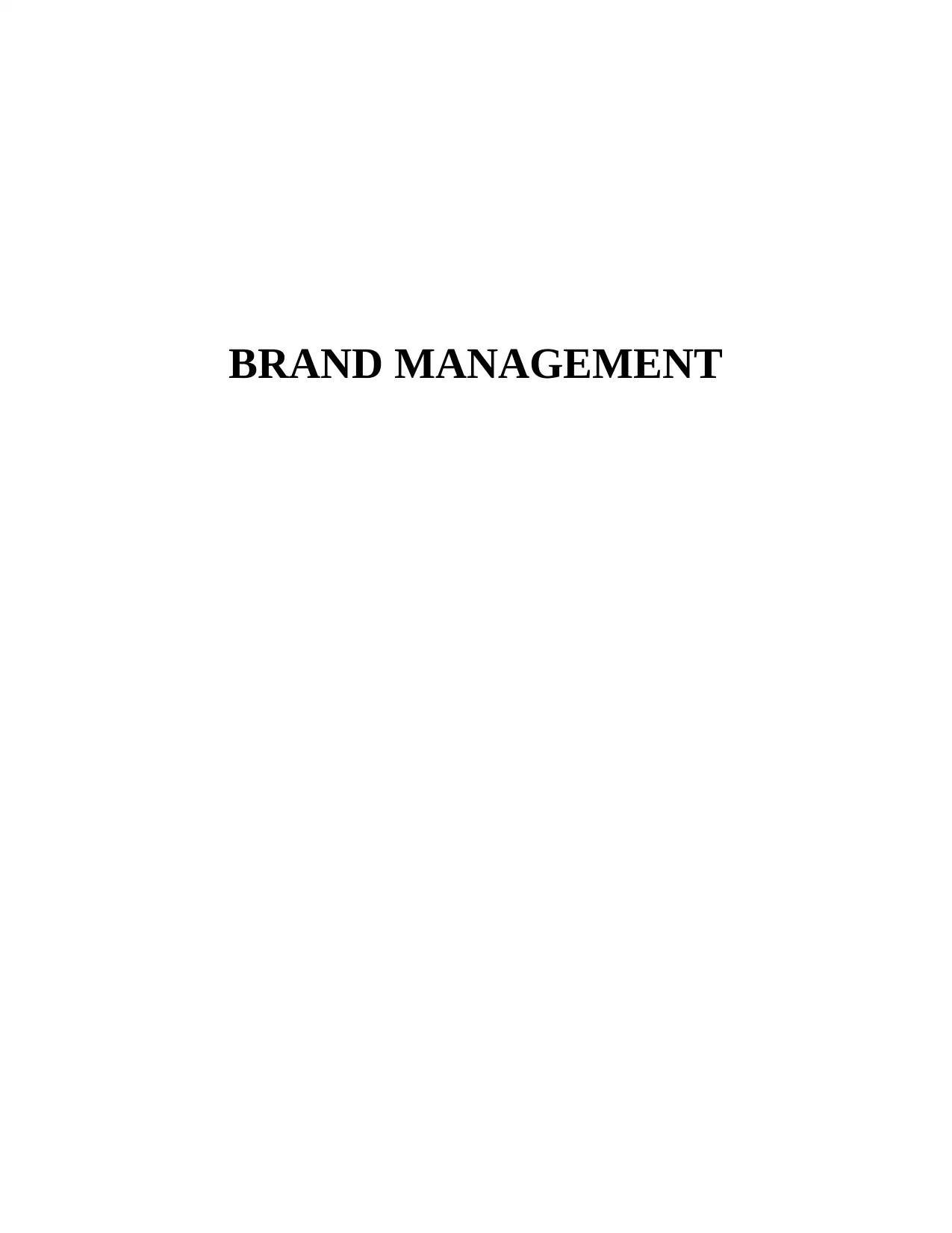
BRAND MANAGEMENT
Paraphrase This Document
Need a fresh take? Get an instant paraphrase of this document with our AI Paraphraser
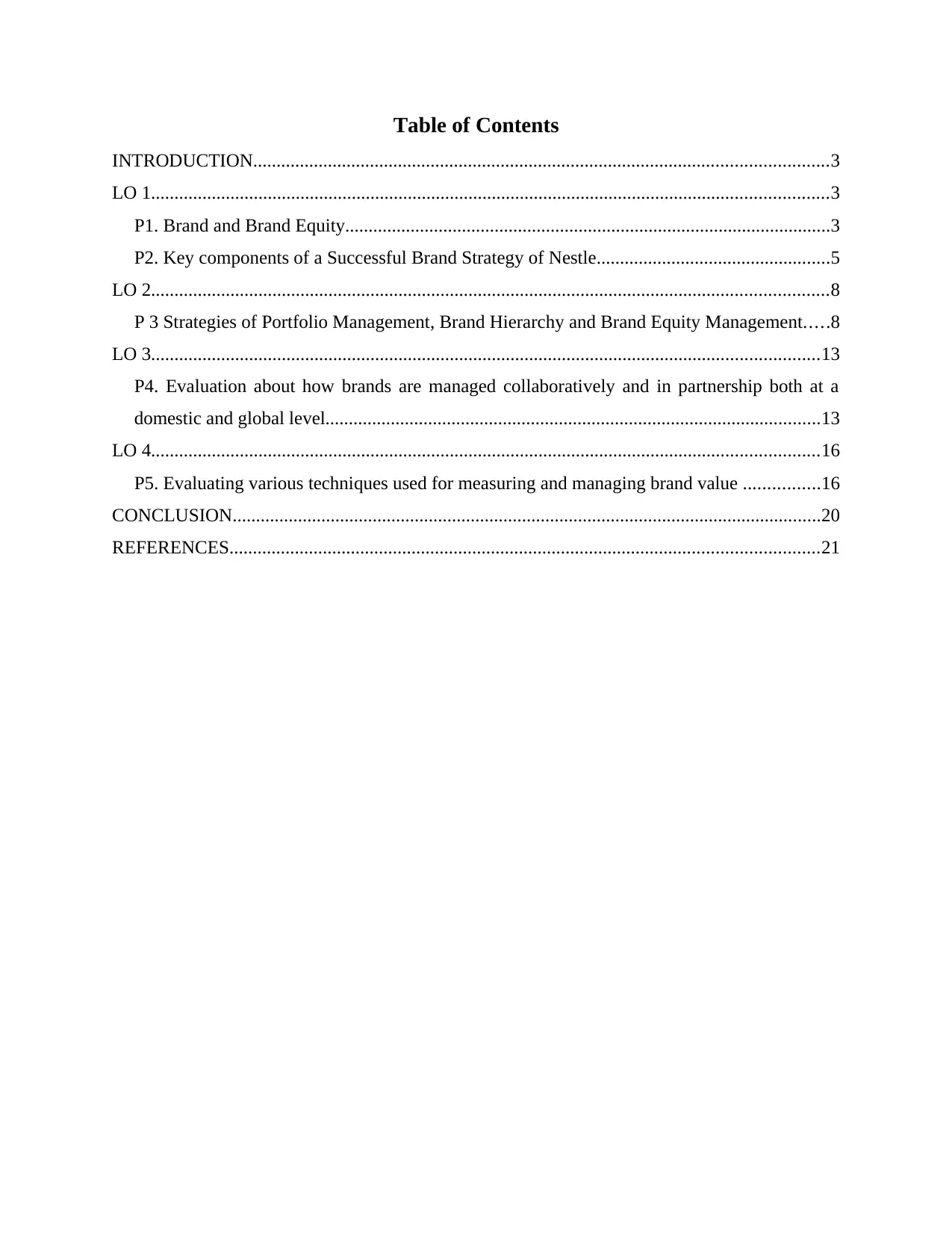
Table of Contents
INTRODUCTION...........................................................................................................................3
LO 1.................................................................................................................................................3
P1. Brand and Brand Equity........................................................................................................3
P2. Key components of a Successful Brand Strategy of Nestle..................................................5
LO 2.................................................................................................................................................8
P 3 Strategies of Portfolio Management, Brand Hierarchy and Brand Equity Management.....8
LO 3...............................................................................................................................................13
P4. Evaluation about how brands are managed collaboratively and in partnership both at a
domestic and global level..........................................................................................................13
LO 4...............................................................................................................................................16
P5. Evaluating various techniques used for measuring and managing brand value ................16
CONCLUSION..............................................................................................................................20
REFERENCES..............................................................................................................................21
INTRODUCTION...........................................................................................................................3
LO 1.................................................................................................................................................3
P1. Brand and Brand Equity........................................................................................................3
P2. Key components of a Successful Brand Strategy of Nestle..................................................5
LO 2.................................................................................................................................................8
P 3 Strategies of Portfolio Management, Brand Hierarchy and Brand Equity Management.....8
LO 3...............................................................................................................................................13
P4. Evaluation about how brands are managed collaboratively and in partnership both at a
domestic and global level..........................................................................................................13
LO 4...............................................................................................................................................16
P5. Evaluating various techniques used for measuring and managing brand value ................16
CONCLUSION..............................................................................................................................20
REFERENCES..............................................................................................................................21

Illustration Index
Illustration 1: Strategic Portfolio Management..............................................................................10
Illustration 2: Customer-Based Brand Equity (CBBE) Model......................................................13
Illustration 1: Strategic Portfolio Management..............................................................................10
Illustration 2: Customer-Based Brand Equity (CBBE) Model......................................................13
⊘ This is a preview!⊘
Do you want full access?
Subscribe today to unlock all pages.

Trusted by 1+ million students worldwide
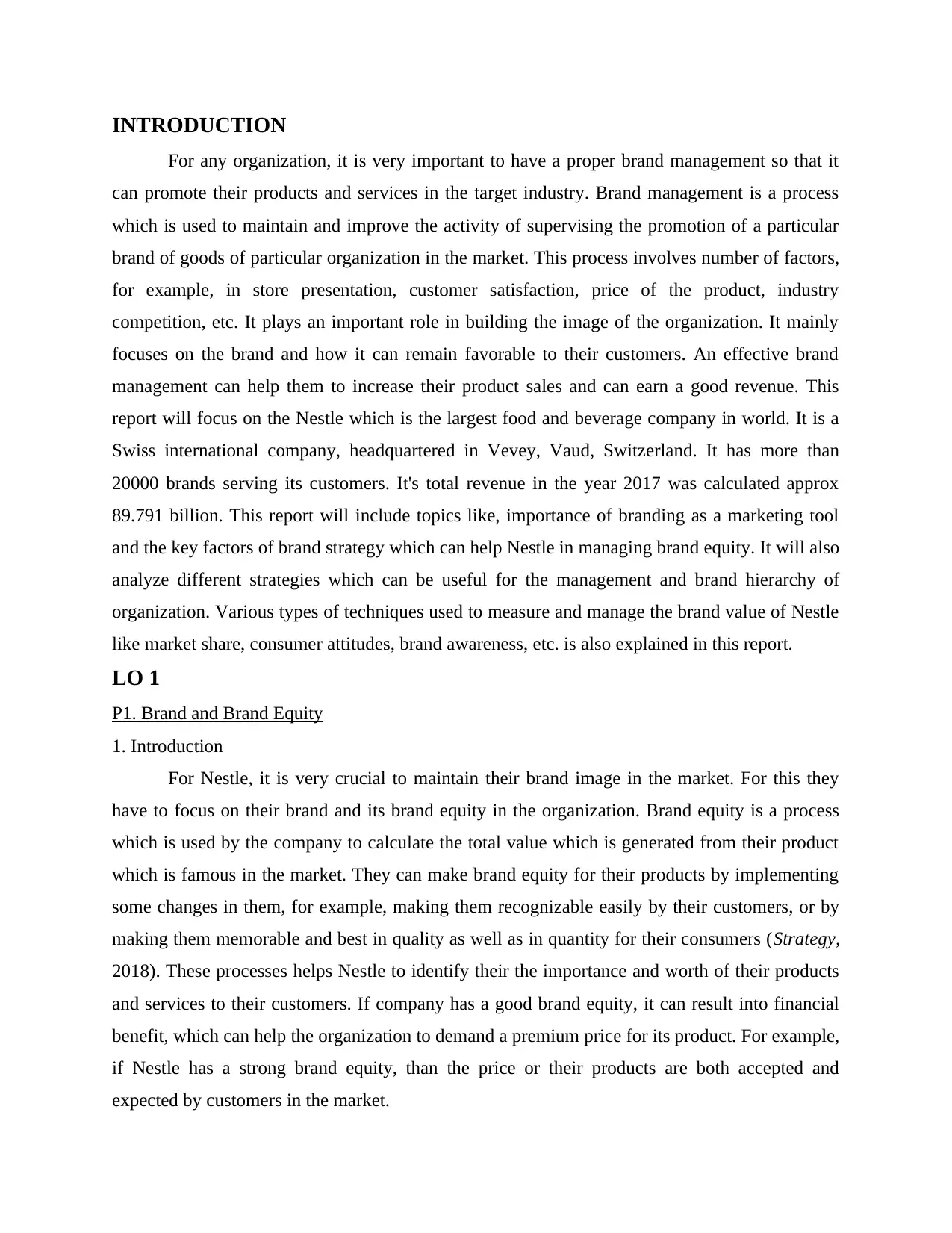
INTRODUCTION
For any organization, it is very important to have a proper brand management so that it
can promote their products and services in the target industry. Brand management is a process
which is used to maintain and improve the activity of supervising the promotion of a particular
brand of goods of particular organization in the market. This process involves number of factors,
for example, in store presentation, customer satisfaction, price of the product, industry
competition, etc. It plays an important role in building the image of the organization. It mainly
focuses on the brand and how it can remain favorable to their customers. An effective brand
management can help them to increase their product sales and can earn a good revenue. This
report will focus on the Nestle which is the largest food and beverage company in world. It is a
Swiss international company, headquartered in Vevey, Vaud, Switzerland. It has more than
20000 brands serving its customers. It's total revenue in the year 2017 was calculated approx
89.791 billion. This report will include topics like, importance of branding as a marketing tool
and the key factors of brand strategy which can help Nestle in managing brand equity. It will also
analyze different strategies which can be useful for the management and brand hierarchy of
organization. Various types of techniques used to measure and manage the brand value of Nestle
like market share, consumer attitudes, brand awareness, etc. is also explained in this report.
LO 1
P1. Brand and Brand Equity
1. Introduction
For Nestle, it is very crucial to maintain their brand image in the market. For this they
have to focus on their brand and its brand equity in the organization. Brand equity is a process
which is used by the company to calculate the total value which is generated from their product
which is famous in the market. They can make brand equity for their products by implementing
some changes in them, for example, making them recognizable easily by their customers, or by
making them memorable and best in quality as well as in quantity for their consumers (Strategy,
2018). These processes helps Nestle to identify their the importance and worth of their products
and services to their customers. If company has a good brand equity, it can result into financial
benefit, which can help the organization to demand a premium price for its product. For example,
if Nestle has a strong brand equity, than the price or their products are both accepted and
expected by customers in the market.
For any organization, it is very important to have a proper brand management so that it
can promote their products and services in the target industry. Brand management is a process
which is used to maintain and improve the activity of supervising the promotion of a particular
brand of goods of particular organization in the market. This process involves number of factors,
for example, in store presentation, customer satisfaction, price of the product, industry
competition, etc. It plays an important role in building the image of the organization. It mainly
focuses on the brand and how it can remain favorable to their customers. An effective brand
management can help them to increase their product sales and can earn a good revenue. This
report will focus on the Nestle which is the largest food and beverage company in world. It is a
Swiss international company, headquartered in Vevey, Vaud, Switzerland. It has more than
20000 brands serving its customers. It's total revenue in the year 2017 was calculated approx
89.791 billion. This report will include topics like, importance of branding as a marketing tool
and the key factors of brand strategy which can help Nestle in managing brand equity. It will also
analyze different strategies which can be useful for the management and brand hierarchy of
organization. Various types of techniques used to measure and manage the brand value of Nestle
like market share, consumer attitudes, brand awareness, etc. is also explained in this report.
LO 1
P1. Brand and Brand Equity
1. Introduction
For Nestle, it is very crucial to maintain their brand image in the market. For this they
have to focus on their brand and its brand equity in the organization. Brand equity is a process
which is used by the company to calculate the total value which is generated from their product
which is famous in the market. They can make brand equity for their products by implementing
some changes in them, for example, making them recognizable easily by their customers, or by
making them memorable and best in quality as well as in quantity for their consumers (Strategy,
2018). These processes helps Nestle to identify their the importance and worth of their products
and services to their customers. If company has a good brand equity, it can result into financial
benefit, which can help the organization to demand a premium price for its product. For example,
if Nestle has a strong brand equity, than the price or their products are both accepted and
expected by customers in the market.
Paraphrase This Document
Need a fresh take? Get an instant paraphrase of this document with our AI Paraphraser
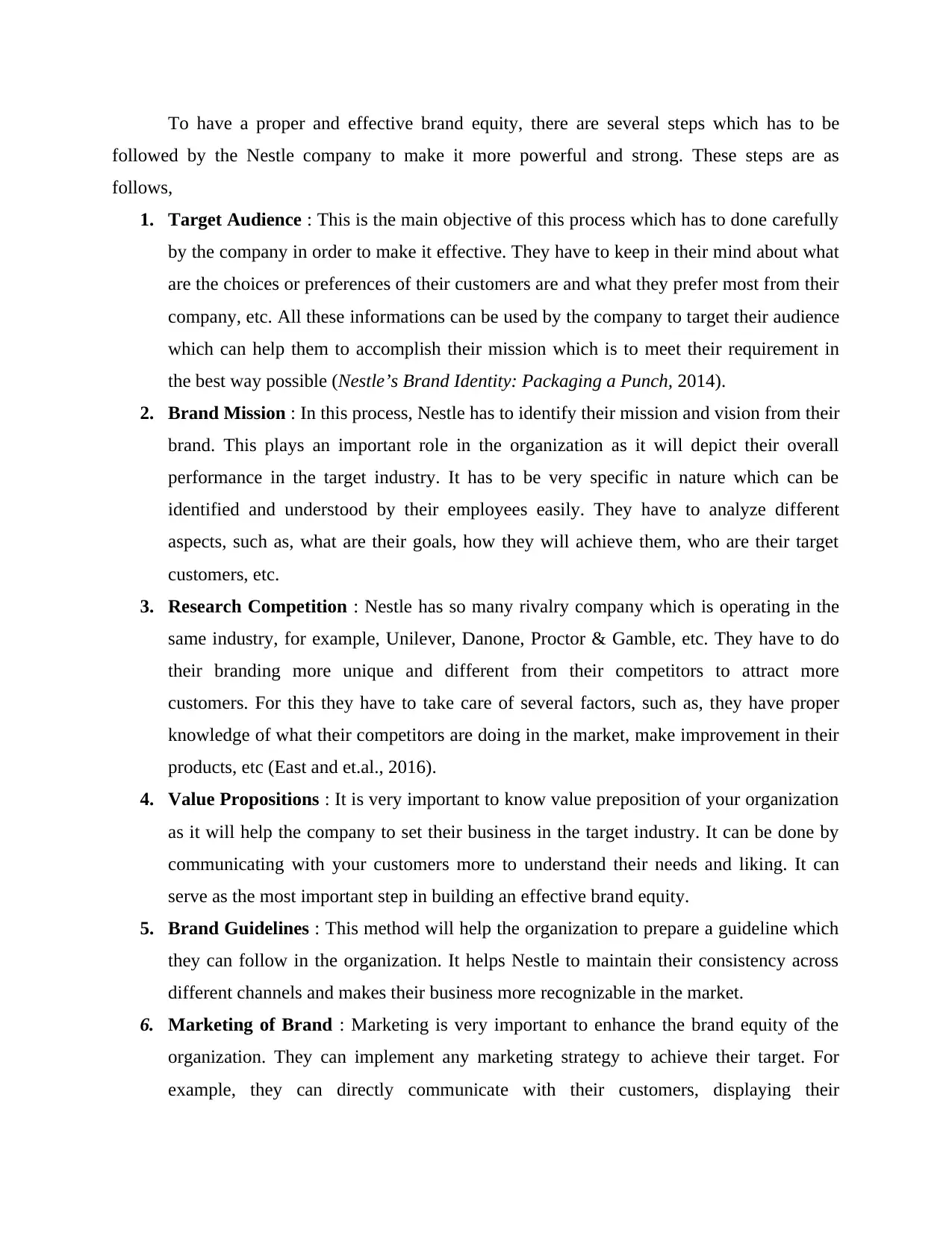
To have a proper and effective brand equity, there are several steps which has to be
followed by the Nestle company to make it more powerful and strong. These steps are as
follows,
1. Target Audience : This is the main objective of this process which has to done carefully
by the company in order to make it effective. They have to keep in their mind about what
are the choices or preferences of their customers are and what they prefer most from their
company, etc. All these informations can be used by the company to target their audience
which can help them to accomplish their mission which is to meet their requirement in
the best way possible (Nestle’s Brand Identity: Packaging a Punch, 2014).
2. Brand Mission : In this process, Nestle has to identify their mission and vision from their
brand. This plays an important role in the organization as it will depict their overall
performance in the target industry. It has to be very specific in nature which can be
identified and understood by their employees easily. They have to analyze different
aspects, such as, what are their goals, how they will achieve them, who are their target
customers, etc.
3. Research Competition : Nestle has so many rivalry company which is operating in the
same industry, for example, Unilever, Danone, Proctor & Gamble, etc. They have to do
their branding more unique and different from their competitors to attract more
customers. For this they have to take care of several factors, such as, they have proper
knowledge of what their competitors are doing in the market, make improvement in their
products, etc (East and et.al., 2016).
4. Value Propositions : It is very important to know value preposition of your organization
as it will help the company to set their business in the target industry. It can be done by
communicating with your customers more to understand their needs and liking. It can
serve as the most important step in building an effective brand equity.
5. Brand Guidelines : This method will help the organization to prepare a guideline which
they can follow in the organization. It helps Nestle to maintain their consistency across
different channels and makes their business more recognizable in the market.
6. Marketing of Brand : Marketing is very important to enhance the brand equity of the
organization. They can implement any marketing strategy to achieve their target. For
example, they can directly communicate with their customers, displaying their
followed by the Nestle company to make it more powerful and strong. These steps are as
follows,
1. Target Audience : This is the main objective of this process which has to done carefully
by the company in order to make it effective. They have to keep in their mind about what
are the choices or preferences of their customers are and what they prefer most from their
company, etc. All these informations can be used by the company to target their audience
which can help them to accomplish their mission which is to meet their requirement in
the best way possible (Nestle’s Brand Identity: Packaging a Punch, 2014).
2. Brand Mission : In this process, Nestle has to identify their mission and vision from their
brand. This plays an important role in the organization as it will depict their overall
performance in the target industry. It has to be very specific in nature which can be
identified and understood by their employees easily. They have to analyze different
aspects, such as, what are their goals, how they will achieve them, who are their target
customers, etc.
3. Research Competition : Nestle has so many rivalry company which is operating in the
same industry, for example, Unilever, Danone, Proctor & Gamble, etc. They have to do
their branding more unique and different from their competitors to attract more
customers. For this they have to take care of several factors, such as, they have proper
knowledge of what their competitors are doing in the market, make improvement in their
products, etc (East and et.al., 2016).
4. Value Propositions : It is very important to know value preposition of your organization
as it will help the company to set their business in the target industry. It can be done by
communicating with your customers more to understand their needs and liking. It can
serve as the most important step in building an effective brand equity.
5. Brand Guidelines : This method will help the organization to prepare a guideline which
they can follow in the organization. It helps Nestle to maintain their consistency across
different channels and makes their business more recognizable in the market.
6. Marketing of Brand : Marketing is very important to enhance the brand equity of the
organization. They can implement any marketing strategy to achieve their target. For
example, they can directly communicate with their customers, displaying their
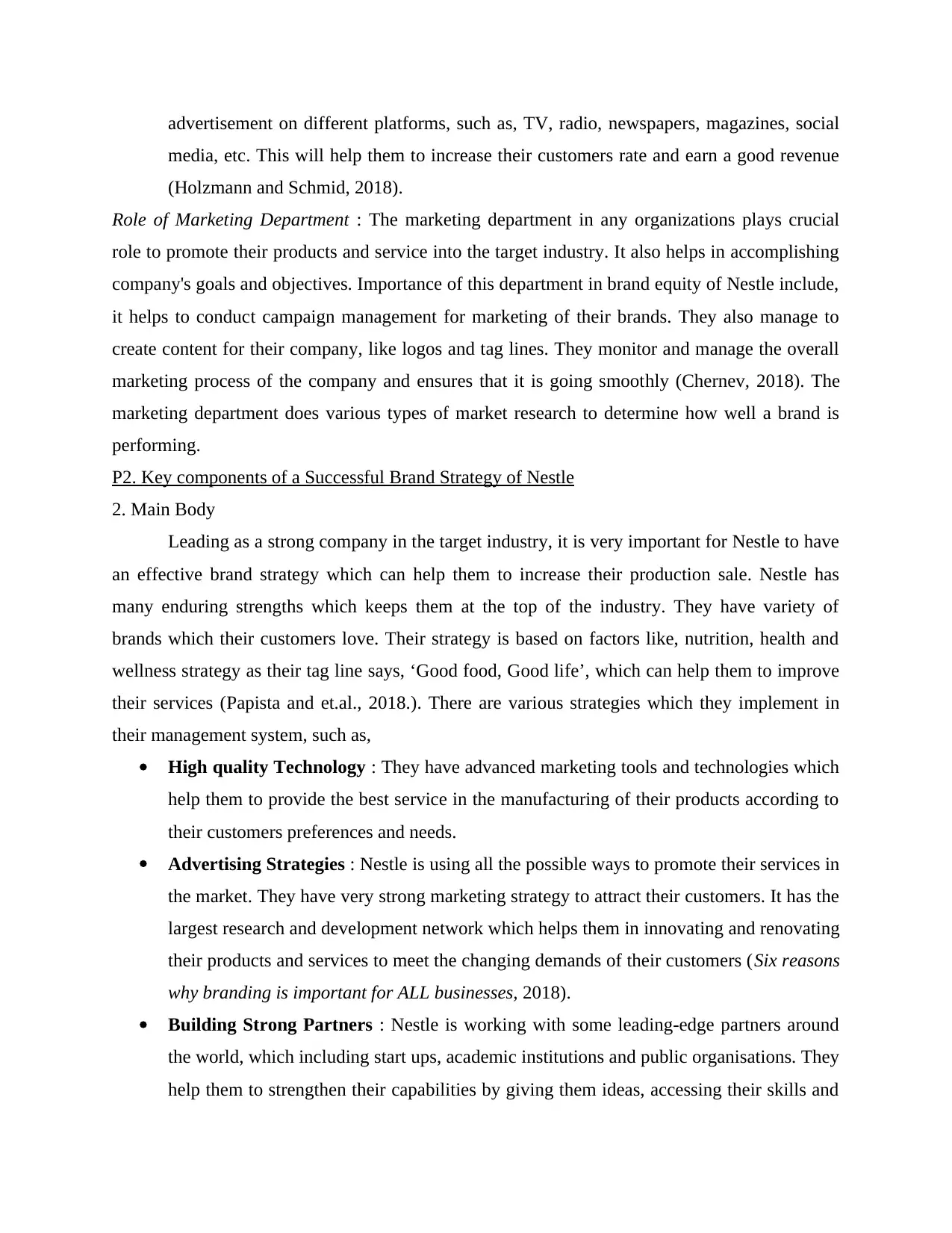
advertisement on different platforms, such as, TV, radio, newspapers, magazines, social
media, etc. This will help them to increase their customers rate and earn a good revenue
(Holzmann and Schmid, 2018).
Role of Marketing Department : The marketing department in any organizations plays crucial
role to promote their products and service into the target industry. It also helps in accomplishing
company's goals and objectives. Importance of this department in brand equity of Nestle include,
it helps to conduct campaign management for marketing of their brands. They also manage to
create content for their company, like logos and tag lines. They monitor and manage the overall
marketing process of the company and ensures that it is going smoothly (Chernev, 2018). The
marketing department does various types of market research to determine how well a brand is
performing.
P2. Key components of a Successful Brand Strategy of Nestle
2. Main Body
Leading as a strong company in the target industry, it is very important for Nestle to have
an effective brand strategy which can help them to increase their production sale. Nestle has
many enduring strengths which keeps them at the top of the industry. They have variety of
brands which their customers love. Their strategy is based on factors like, nutrition, health and
wellness strategy as their tag line says, ‘Good food, Good life’, which can help them to improve
their services (Papista and et.al., 2018.). There are various strategies which they implement in
their management system, such as,
High quality Technology : They have advanced marketing tools and technologies which
help them to provide the best service in the manufacturing of their products according to
their customers preferences and needs.
Advertising Strategies : Nestle is using all the possible ways to promote their services in
the market. They have very strong marketing strategy to attract their customers. It has the
largest research and development network which helps them in innovating and renovating
their products and services to meet the changing demands of their customers (Six reasons
why branding is important for ALL businesses, 2018).
Building Strong Partners : Nestle is working with some leading-edge partners around
the world, which including start ups, academic institutions and public organisations. They
help them to strengthen their capabilities by giving them ideas, accessing their skills and
media, etc. This will help them to increase their customers rate and earn a good revenue
(Holzmann and Schmid, 2018).
Role of Marketing Department : The marketing department in any organizations plays crucial
role to promote their products and service into the target industry. It also helps in accomplishing
company's goals and objectives. Importance of this department in brand equity of Nestle include,
it helps to conduct campaign management for marketing of their brands. They also manage to
create content for their company, like logos and tag lines. They monitor and manage the overall
marketing process of the company and ensures that it is going smoothly (Chernev, 2018). The
marketing department does various types of market research to determine how well a brand is
performing.
P2. Key components of a Successful Brand Strategy of Nestle
2. Main Body
Leading as a strong company in the target industry, it is very important for Nestle to have
an effective brand strategy which can help them to increase their production sale. Nestle has
many enduring strengths which keeps them at the top of the industry. They have variety of
brands which their customers love. Their strategy is based on factors like, nutrition, health and
wellness strategy as their tag line says, ‘Good food, Good life’, which can help them to improve
their services (Papista and et.al., 2018.). There are various strategies which they implement in
their management system, such as,
High quality Technology : They have advanced marketing tools and technologies which
help them to provide the best service in the manufacturing of their products according to
their customers preferences and needs.
Advertising Strategies : Nestle is using all the possible ways to promote their services in
the market. They have very strong marketing strategy to attract their customers. It has the
largest research and development network which helps them in innovating and renovating
their products and services to meet the changing demands of their customers (Six reasons
why branding is important for ALL businesses, 2018).
Building Strong Partners : Nestle is working with some leading-edge partners around
the world, which including start ups, academic institutions and public organisations. They
help them to strengthen their capabilities by giving them ideas, accessing their skills and
⊘ This is a preview!⊘
Do you want full access?
Subscribe today to unlock all pages.

Trusted by 1+ million students worldwide
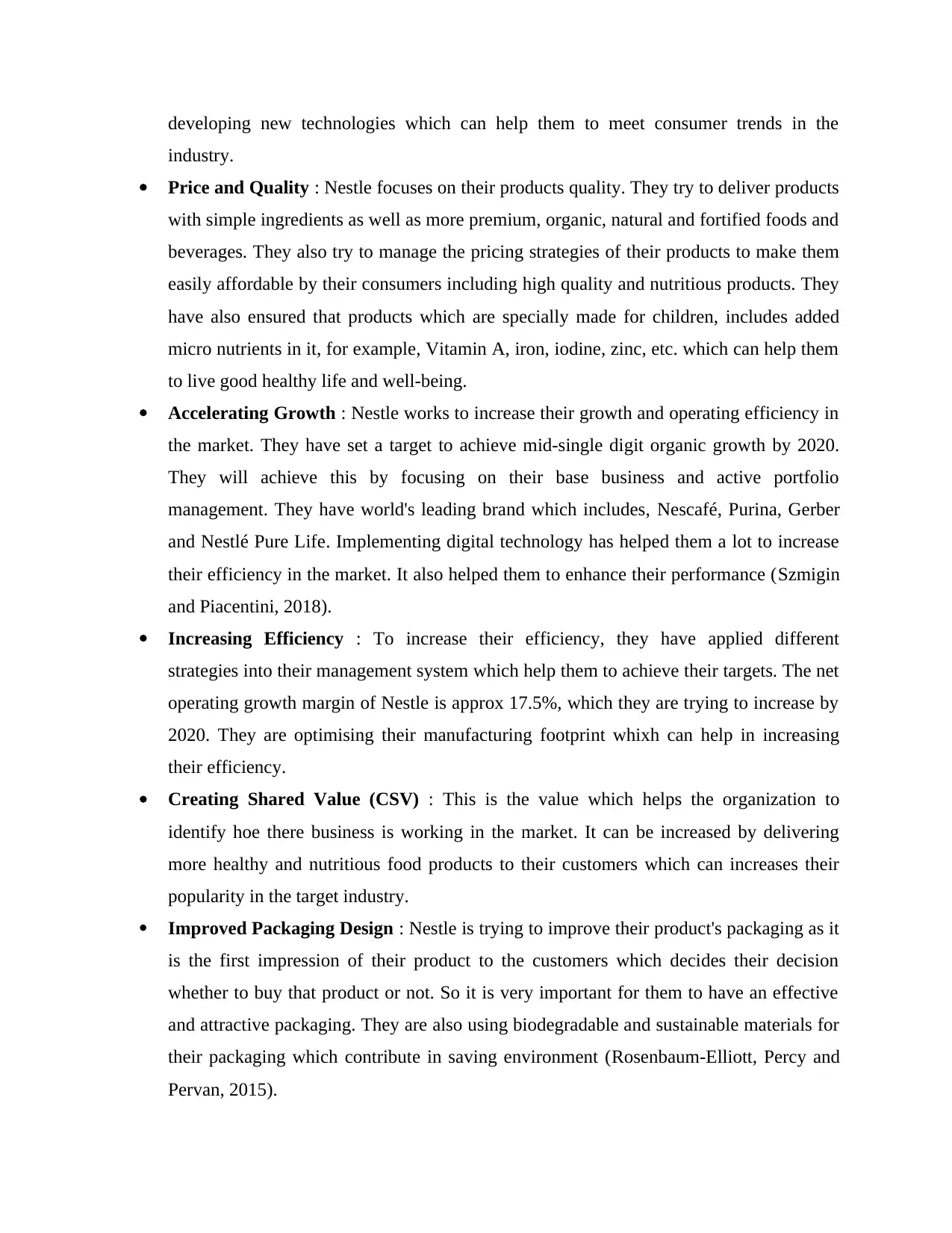
developing new technologies which can help them to meet consumer trends in the
industry.
Price and Quality : Nestle focuses on their products quality. They try to deliver products
with simple ingredients as well as more premium, organic, natural and fortified foods and
beverages. They also try to manage the pricing strategies of their products to make them
easily affordable by their consumers including high quality and nutritious products. They
have also ensured that products which are specially made for children, includes added
micro nutrients in it, for example, Vitamin A, iron, iodine, zinc, etc. which can help them
to live good healthy life and well-being.
Accelerating Growth : Nestle works to increase their growth and operating efficiency in
the market. They have set a target to achieve mid-single digit organic growth by 2020.
They will achieve this by focusing on their base business and active portfolio
management. They have world's leading brand which includes, Nescafé, Purina, Gerber
and Nestlé Pure Life. Implementing digital technology has helped them a lot to increase
their efficiency in the market. It also helped them to enhance their performance (Szmigin
and Piacentini, 2018).
Increasing Efficiency : To increase their efficiency, they have applied different
strategies into their management system which help them to achieve their targets. The net
operating growth margin of Nestle is approx 17.5%, which they are trying to increase by
2020. They are optimising their manufacturing footprint whixh can help in increasing
their efficiency.
Creating Shared Value (CSV) : This is the value which helps the organization to
identify hoe there business is working in the market. It can be increased by delivering
more healthy and nutritious food products to their customers which can increases their
popularity in the target industry.
Improved Packaging Design : Nestle is trying to improve their product's packaging as it
is the first impression of their product to the customers which decides their decision
whether to buy that product or not. So it is very important for them to have an effective
and attractive packaging. They are also using biodegradable and sustainable materials for
their packaging which contribute in saving environment (Rosenbaum-Elliott, Percy and
Pervan, 2015).
industry.
Price and Quality : Nestle focuses on their products quality. They try to deliver products
with simple ingredients as well as more premium, organic, natural and fortified foods and
beverages. They also try to manage the pricing strategies of their products to make them
easily affordable by their consumers including high quality and nutritious products. They
have also ensured that products which are specially made for children, includes added
micro nutrients in it, for example, Vitamin A, iron, iodine, zinc, etc. which can help them
to live good healthy life and well-being.
Accelerating Growth : Nestle works to increase their growth and operating efficiency in
the market. They have set a target to achieve mid-single digit organic growth by 2020.
They will achieve this by focusing on their base business and active portfolio
management. They have world's leading brand which includes, Nescafé, Purina, Gerber
and Nestlé Pure Life. Implementing digital technology has helped them a lot to increase
their efficiency in the market. It also helped them to enhance their performance (Szmigin
and Piacentini, 2018).
Increasing Efficiency : To increase their efficiency, they have applied different
strategies into their management system which help them to achieve their targets. The net
operating growth margin of Nestle is approx 17.5%, which they are trying to increase by
2020. They are optimising their manufacturing footprint whixh can help in increasing
their efficiency.
Creating Shared Value (CSV) : This is the value which helps the organization to
identify hoe there business is working in the market. It can be increased by delivering
more healthy and nutritious food products to their customers which can increases their
popularity in the target industry.
Improved Packaging Design : Nestle is trying to improve their product's packaging as it
is the first impression of their product to the customers which decides their decision
whether to buy that product or not. So it is very important for them to have an effective
and attractive packaging. They are also using biodegradable and sustainable materials for
their packaging which contribute in saving environment (Rosenbaum-Elliott, Percy and
Pervan, 2015).
Paraphrase This Document
Need a fresh take? Get an instant paraphrase of this document with our AI Paraphraser
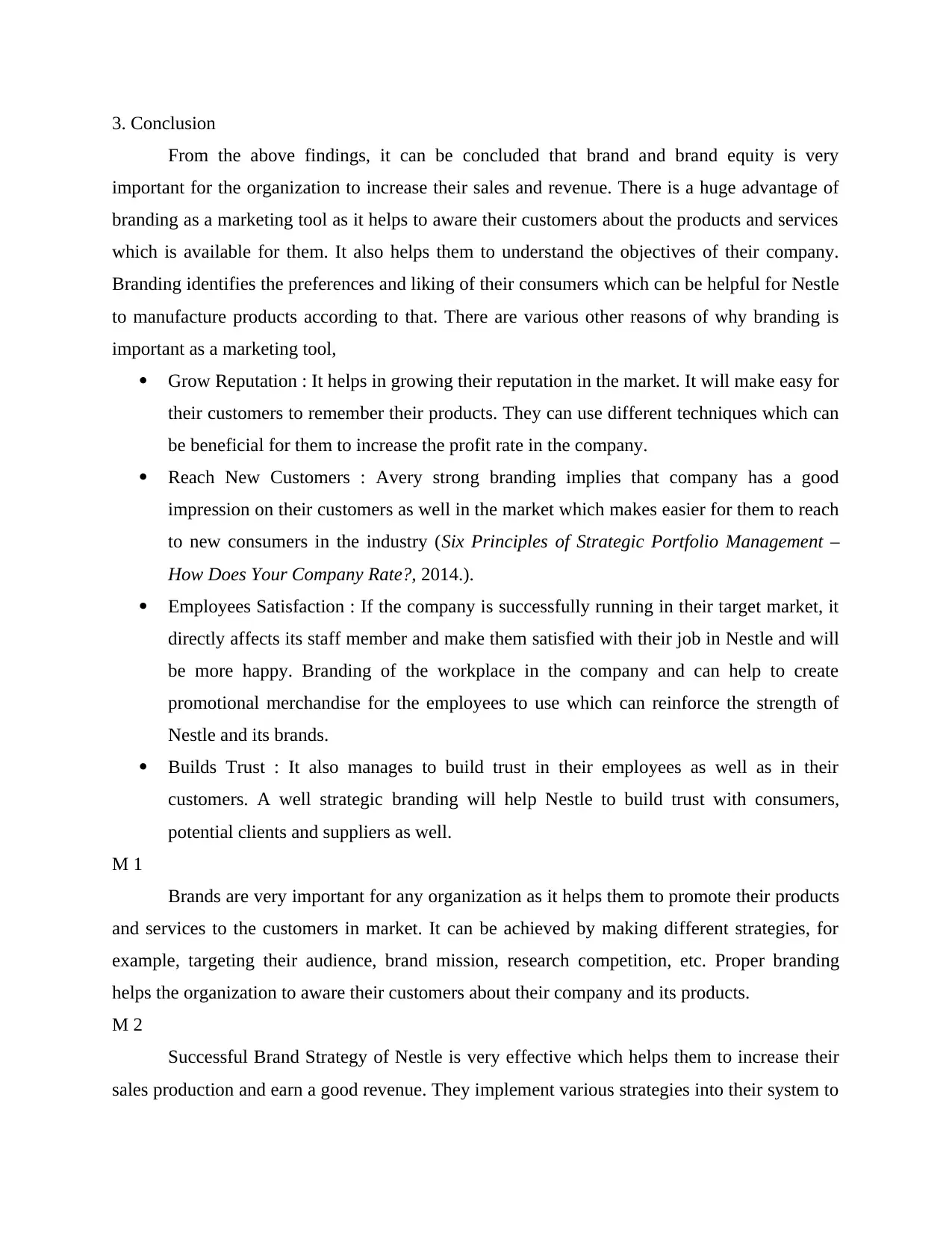
3. Conclusion
From the above findings, it can be concluded that brand and brand equity is very
important for the organization to increase their sales and revenue. There is a huge advantage of
branding as a marketing tool as it helps to aware their customers about the products and services
which is available for them. It also helps them to understand the objectives of their company.
Branding identifies the preferences and liking of their consumers which can be helpful for Nestle
to manufacture products according to that. There are various other reasons of why branding is
important as a marketing tool,
Grow Reputation : It helps in growing their reputation in the market. It will make easy for
their customers to remember their products. They can use different techniques which can
be beneficial for them to increase the profit rate in the company.
Reach New Customers : Avery strong branding implies that company has a good
impression on their customers as well in the market which makes easier for them to reach
to new consumers in the industry (Six Principles of Strategic Portfolio Management –
How Does Your Company Rate?, 2014.).
Employees Satisfaction : If the company is successfully running in their target market, it
directly affects its staff member and make them satisfied with their job in Nestle and will
be more happy. Branding of the workplace in the company and can help to create
promotional merchandise for the employees to use which can reinforce the strength of
Nestle and its brands.
Builds Trust : It also manages to build trust in their employees as well as in their
customers. A well strategic branding will help Nestle to build trust with consumers,
potential clients and suppliers as well.
M 1
Brands are very important for any organization as it helps them to promote their products
and services to the customers in market. It can be achieved by making different strategies, for
example, targeting their audience, brand mission, research competition, etc. Proper branding
helps the organization to aware their customers about their company and its products.
M 2
Successful Brand Strategy of Nestle is very effective which helps them to increase their
sales production and earn a good revenue. They implement various strategies into their system to
From the above findings, it can be concluded that brand and brand equity is very
important for the organization to increase their sales and revenue. There is a huge advantage of
branding as a marketing tool as it helps to aware their customers about the products and services
which is available for them. It also helps them to understand the objectives of their company.
Branding identifies the preferences and liking of their consumers which can be helpful for Nestle
to manufacture products according to that. There are various other reasons of why branding is
important as a marketing tool,
Grow Reputation : It helps in growing their reputation in the market. It will make easy for
their customers to remember their products. They can use different techniques which can
be beneficial for them to increase the profit rate in the company.
Reach New Customers : Avery strong branding implies that company has a good
impression on their customers as well in the market which makes easier for them to reach
to new consumers in the industry (Six Principles of Strategic Portfolio Management –
How Does Your Company Rate?, 2014.).
Employees Satisfaction : If the company is successfully running in their target market, it
directly affects its staff member and make them satisfied with their job in Nestle and will
be more happy. Branding of the workplace in the company and can help to create
promotional merchandise for the employees to use which can reinforce the strength of
Nestle and its brands.
Builds Trust : It also manages to build trust in their employees as well as in their
customers. A well strategic branding will help Nestle to build trust with consumers,
potential clients and suppliers as well.
M 1
Brands are very important for any organization as it helps them to promote their products
and services to the customers in market. It can be achieved by making different strategies, for
example, targeting their audience, brand mission, research competition, etc. Proper branding
helps the organization to aware their customers about their company and its products.
M 2
Successful Brand Strategy of Nestle is very effective which helps them to increase their
sales production and earn a good revenue. They implement various strategies into their system to
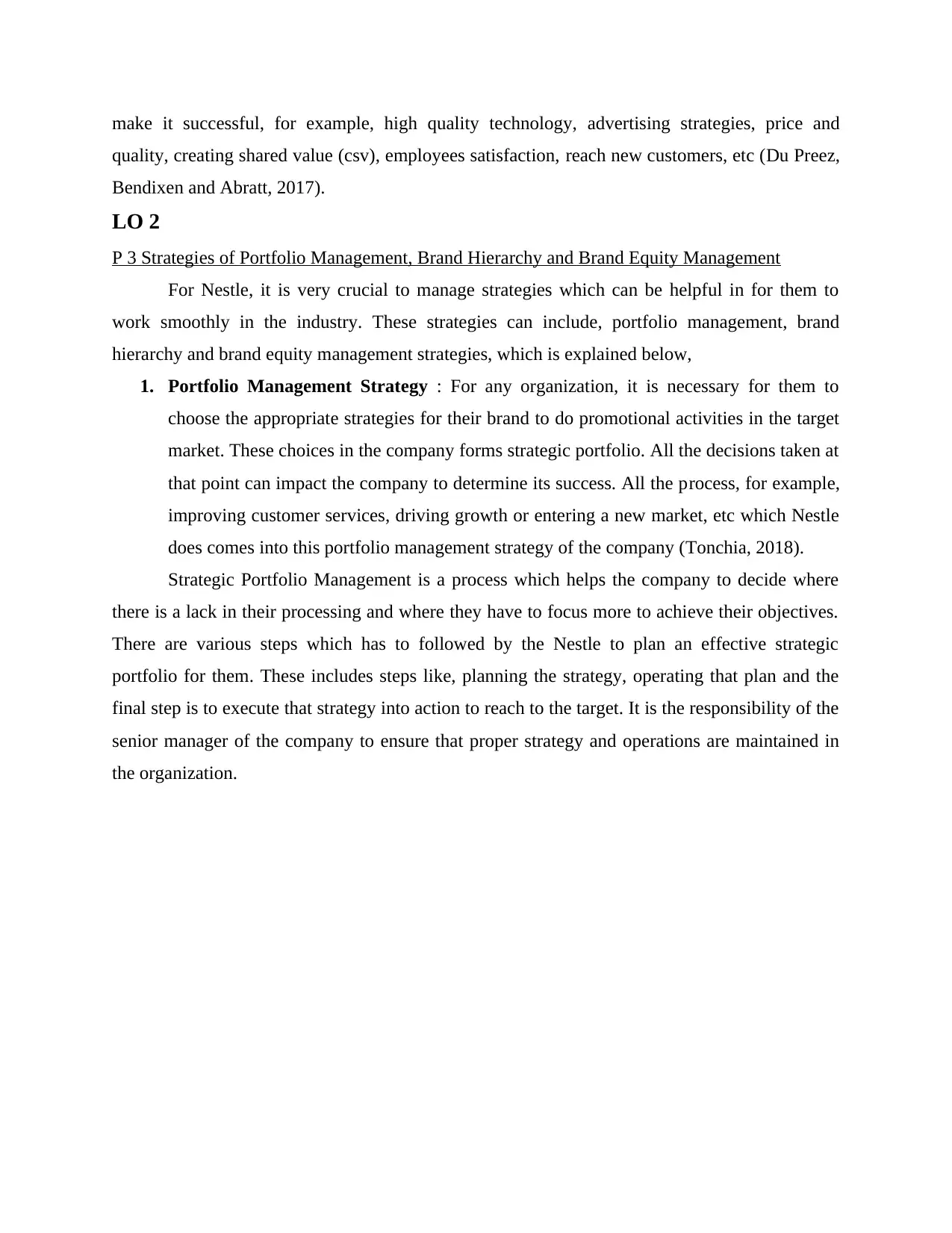
make it successful, for example, high quality technology, advertising strategies, price and
quality, creating shared value (csv), employees satisfaction, reach new customers, etc (Du Preez,
Bendixen and Abratt, 2017).
LO 2
P 3 Strategies of Portfolio Management, Brand Hierarchy and Brand Equity Management
For Nestle, it is very crucial to manage strategies which can be helpful in for them to
work smoothly in the industry. These strategies can include, portfolio management, brand
hierarchy and brand equity management strategies, which is explained below,
1. Portfolio Management Strategy : For any organization, it is necessary for them to
choose the appropriate strategies for their brand to do promotional activities in the target
market. These choices in the company forms strategic portfolio. All the decisions taken at
that point can impact the company to determine its success. All the process, for example,
improving customer services, driving growth or entering a new market, etc which Nestle
does comes into this portfolio management strategy of the company (Tonchia, 2018).
Strategic Portfolio Management is a process which helps the company to decide where
there is a lack in their processing and where they have to focus more to achieve their objectives.
There are various steps which has to followed by the Nestle to plan an effective strategic
portfolio for them. These includes steps like, planning the strategy, operating that plan and the
final step is to execute that strategy into action to reach to the target. It is the responsibility of the
senior manager of the company to ensure that proper strategy and operations are maintained in
the organization.
quality, creating shared value (csv), employees satisfaction, reach new customers, etc (Du Preez,
Bendixen and Abratt, 2017).
LO 2
P 3 Strategies of Portfolio Management, Brand Hierarchy and Brand Equity Management
For Nestle, it is very crucial to manage strategies which can be helpful in for them to
work smoothly in the industry. These strategies can include, portfolio management, brand
hierarchy and brand equity management strategies, which is explained below,
1. Portfolio Management Strategy : For any organization, it is necessary for them to
choose the appropriate strategies for their brand to do promotional activities in the target
market. These choices in the company forms strategic portfolio. All the decisions taken at
that point can impact the company to determine its success. All the process, for example,
improving customer services, driving growth or entering a new market, etc which Nestle
does comes into this portfolio management strategy of the company (Tonchia, 2018).
Strategic Portfolio Management is a process which helps the company to decide where
there is a lack in their processing and where they have to focus more to achieve their objectives.
There are various steps which has to followed by the Nestle to plan an effective strategic
portfolio for them. These includes steps like, planning the strategy, operating that plan and the
final step is to execute that strategy into action to reach to the target. It is the responsibility of the
senior manager of the company to ensure that proper strategy and operations are maintained in
the organization.
⊘ This is a preview!⊘
Do you want full access?
Subscribe today to unlock all pages.

Trusted by 1+ million students worldwide
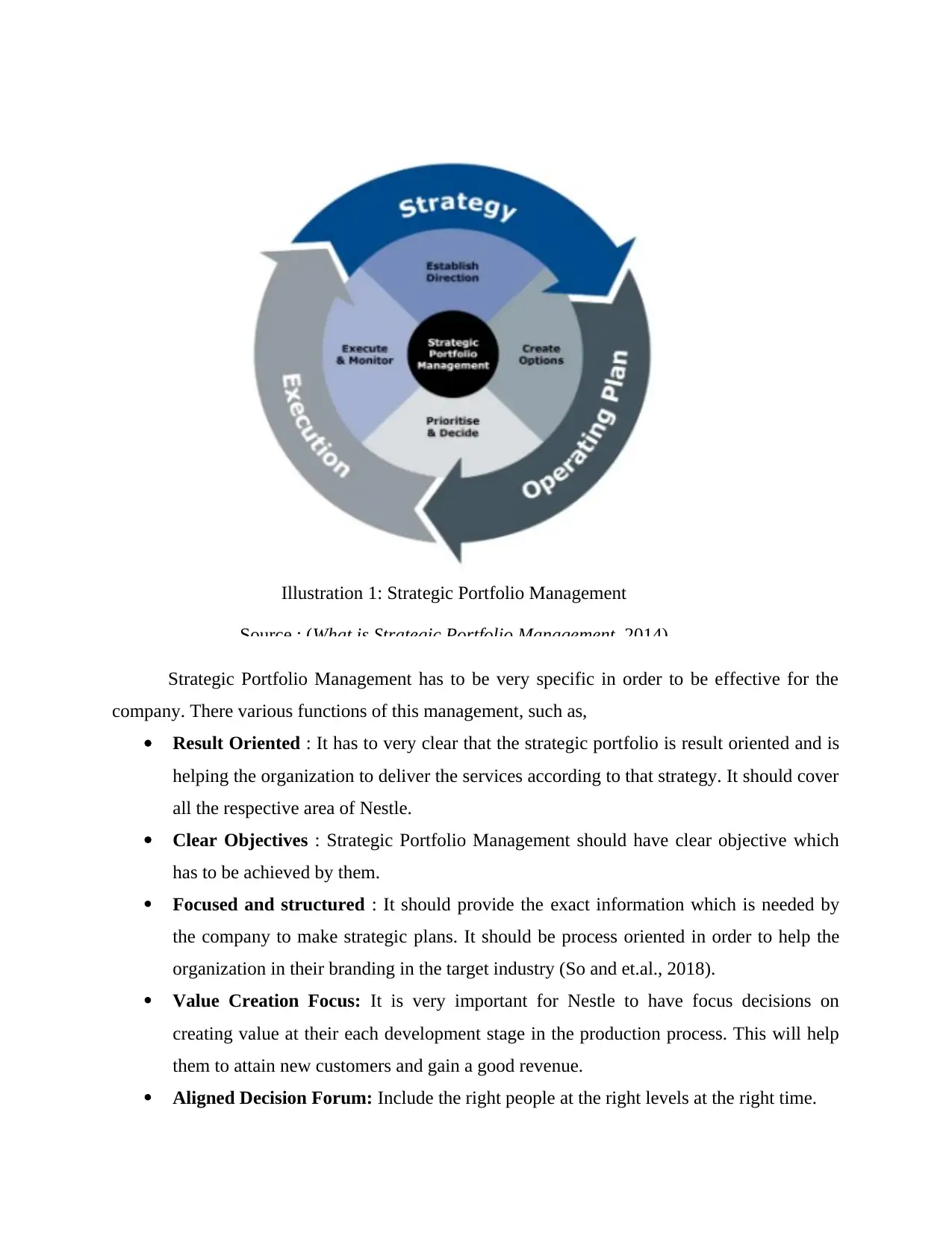
Strategic Portfolio Management has to be very specific in order to be effective for the
company. There various functions of this management, such as,
Result Oriented : It has to very clear that the strategic portfolio is result oriented and is
helping the organization to deliver the services according to that strategy. It should cover
all the respective area of Nestle.
Clear Objectives : Strategic Portfolio Management should have clear objective which
has to be achieved by them.
Focused and structured : It should provide the exact information which is needed by
the company to make strategic plans. It should be process oriented in order to help the
organization in their branding in the target industry (So and et.al., 2018).
Value Creation Focus: It is very important for Nestle to have focus decisions on
creating value at their each development stage in the production process. This will help
them to attain new customers and gain a good revenue.
Aligned Decision Forum: Include the right people at the right levels at the right time.
Illustration 1: Strategic Portfolio Management
Source : (What is Strategic Portfolio Management, 2014)
company. There various functions of this management, such as,
Result Oriented : It has to very clear that the strategic portfolio is result oriented and is
helping the organization to deliver the services according to that strategy. It should cover
all the respective area of Nestle.
Clear Objectives : Strategic Portfolio Management should have clear objective which
has to be achieved by them.
Focused and structured : It should provide the exact information which is needed by
the company to make strategic plans. It should be process oriented in order to help the
organization in their branding in the target industry (So and et.al., 2018).
Value Creation Focus: It is very important for Nestle to have focus decisions on
creating value at their each development stage in the production process. This will help
them to attain new customers and gain a good revenue.
Aligned Decision Forum: Include the right people at the right levels at the right time.
Illustration 1: Strategic Portfolio Management
Source : (What is Strategic Portfolio Management, 2014)
Paraphrase This Document
Need a fresh take? Get an instant paraphrase of this document with our AI Paraphraser
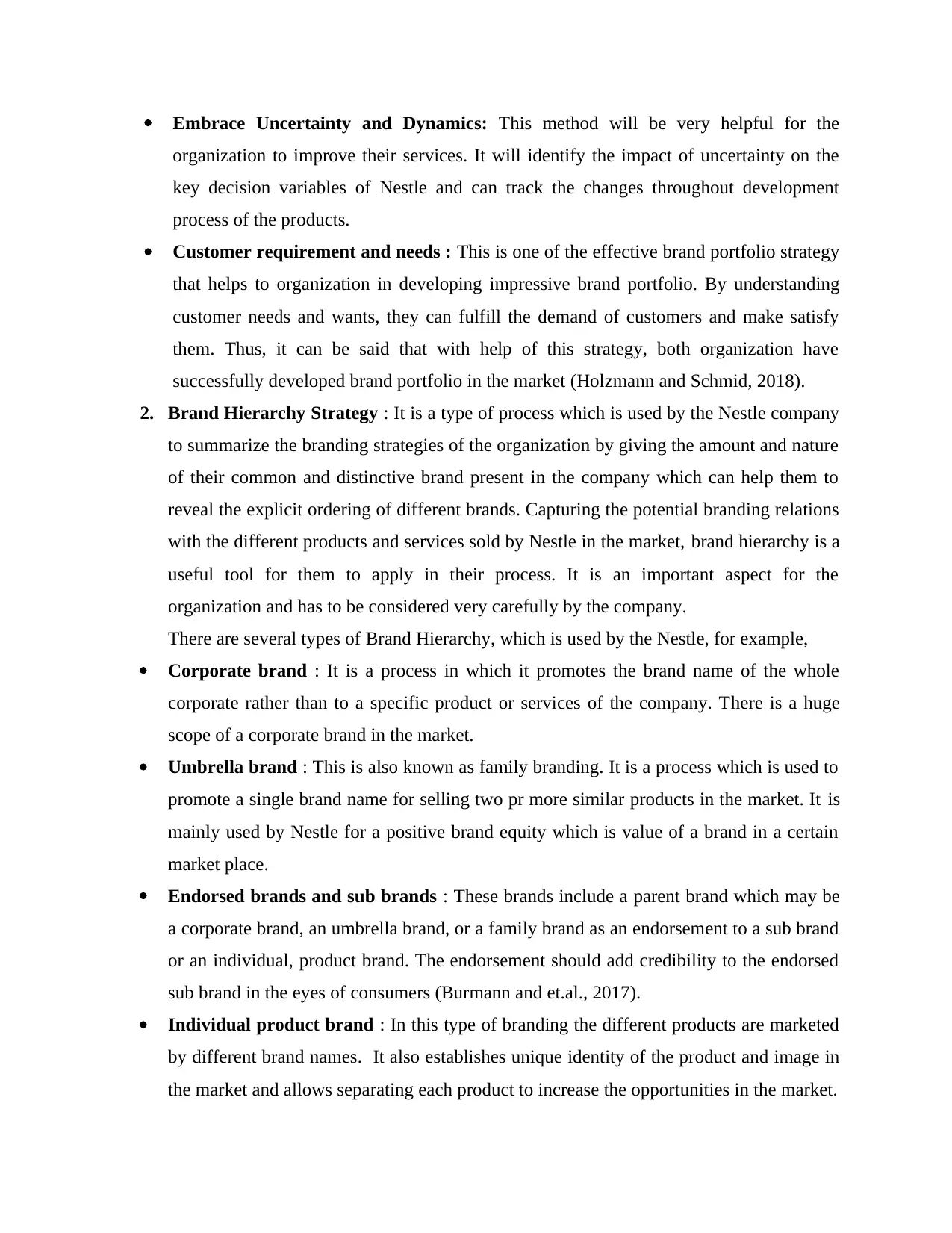
Embrace Uncertainty and Dynamics: This method will be very helpful for the
organization to improve their services. It will identify the impact of uncertainty on the
key decision variables of Nestle and can track the changes throughout development
process of the products.
Customer requirement and needs : This is one of the effective brand portfolio strategy
that helps to organization in developing impressive brand portfolio. By understanding
customer needs and wants, they can fulfill the demand of customers and make satisfy
them. Thus, it can be said that with help of this strategy, both organization have
successfully developed brand portfolio in the market (Holzmann and Schmid, 2018).
2. Brand Hierarchy Strategy : It is a type of process which is used by the Nestle company
to summarize the branding strategies of the organization by giving the amount and nature
of their common and distinctive brand present in the company which can help them to
reveal the explicit ordering of different brands. Capturing the potential branding relations
with the different products and services sold by Nestle in the market, brand hierarchy is a
useful tool for them to apply in their process. It is an important aspect for the
organization and has to be considered very carefully by the company.
There are several types of Brand Hierarchy, which is used by the Nestle, for example,
Corporate brand : It is a process in which it promotes the brand name of the whole
corporate rather than to a specific product or services of the company. There is a huge
scope of a corporate brand in the market.
Umbrella brand : This is also known as family branding. It is a process which is used to
promote a single brand name for selling two pr more similar products in the market. It is
mainly used by Nestle for a positive brand equity which is value of a brand in a certain
market place.
Endorsed brands and sub brands : These brands include a parent brand which may be
a corporate brand, an umbrella brand, or a family brand as an endorsement to a sub brand
or an individual, product brand. The endorsement should add credibility to the endorsed
sub brand in the eyes of consumers (Burmann and et.al., 2017).
Individual product brand : In this type of branding the different products are marketed
by different brand names. It also establishes unique identity of the product and image in
the market and allows separating each product to increase the opportunities in the market.
organization to improve their services. It will identify the impact of uncertainty on the
key decision variables of Nestle and can track the changes throughout development
process of the products.
Customer requirement and needs : This is one of the effective brand portfolio strategy
that helps to organization in developing impressive brand portfolio. By understanding
customer needs and wants, they can fulfill the demand of customers and make satisfy
them. Thus, it can be said that with help of this strategy, both organization have
successfully developed brand portfolio in the market (Holzmann and Schmid, 2018).
2. Brand Hierarchy Strategy : It is a type of process which is used by the Nestle company
to summarize the branding strategies of the organization by giving the amount and nature
of their common and distinctive brand present in the company which can help them to
reveal the explicit ordering of different brands. Capturing the potential branding relations
with the different products and services sold by Nestle in the market, brand hierarchy is a
useful tool for them to apply in their process. It is an important aspect for the
organization and has to be considered very carefully by the company.
There are several types of Brand Hierarchy, which is used by the Nestle, for example,
Corporate brand : It is a process in which it promotes the brand name of the whole
corporate rather than to a specific product or services of the company. There is a huge
scope of a corporate brand in the market.
Umbrella brand : This is also known as family branding. It is a process which is used to
promote a single brand name for selling two pr more similar products in the market. It is
mainly used by Nestle for a positive brand equity which is value of a brand in a certain
market place.
Endorsed brands and sub brands : These brands include a parent brand which may be
a corporate brand, an umbrella brand, or a family brand as an endorsement to a sub brand
or an individual, product brand. The endorsement should add credibility to the endorsed
sub brand in the eyes of consumers (Burmann and et.al., 2017).
Individual product brand : In this type of branding the different products are marketed
by different brand names. It also establishes unique identity of the product and image in
the market and allows separating each product to increase the opportunities in the market.
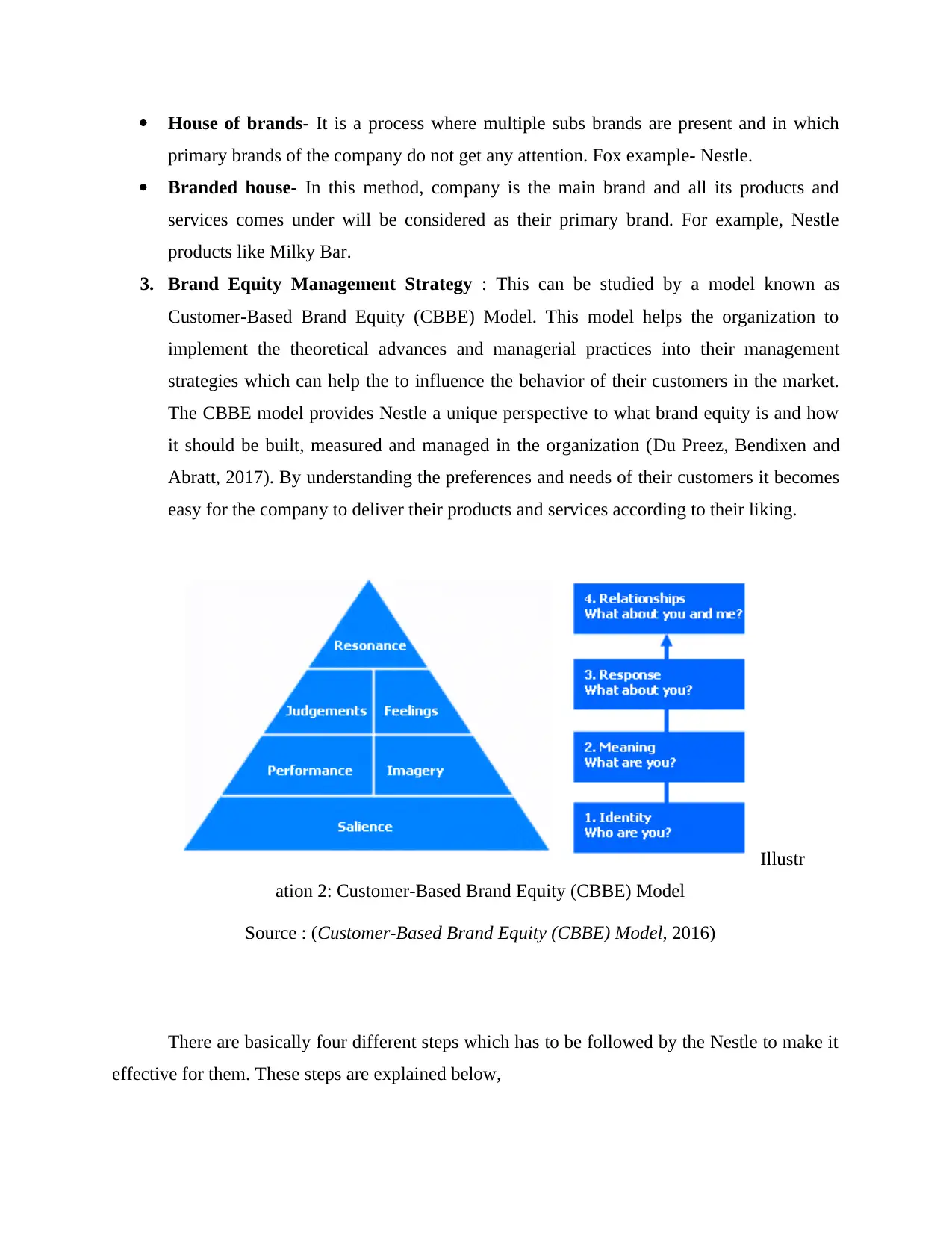
House of brands- It is a process where multiple subs brands are present and in which
primary brands of the company do not get any attention. Fox example- Nestle.
Branded house- In this method, company is the main brand and all its products and
services comes under will be considered as their primary brand. For example, Nestle
products like Milky Bar.
3. Brand Equity Management Strategy : This can be studied by a model known as
Customer-Based Brand Equity (CBBE) Model. This model helps the organization to
implement the theoretical advances and managerial practices into their management
strategies which can help the to influence the behavior of their customers in the market.
The CBBE model provides Nestle a unique perspective to what brand equity is and how
it should be built, measured and managed in the organization (Du Preez, Bendixen and
Abratt, 2017). By understanding the preferences and needs of their customers it becomes
easy for the company to deliver their products and services according to their liking.
There are basically four different steps which has to be followed by the Nestle to make it
effective for them. These steps are explained below,
Illustr
ation 2: Customer-Based Brand Equity (CBBE) Model
Source : (Customer-Based Brand Equity (CBBE) Model, 2016)
primary brands of the company do not get any attention. Fox example- Nestle.
Branded house- In this method, company is the main brand and all its products and
services comes under will be considered as their primary brand. For example, Nestle
products like Milky Bar.
3. Brand Equity Management Strategy : This can be studied by a model known as
Customer-Based Brand Equity (CBBE) Model. This model helps the organization to
implement the theoretical advances and managerial practices into their management
strategies which can help the to influence the behavior of their customers in the market.
The CBBE model provides Nestle a unique perspective to what brand equity is and how
it should be built, measured and managed in the organization (Du Preez, Bendixen and
Abratt, 2017). By understanding the preferences and needs of their customers it becomes
easy for the company to deliver their products and services according to their liking.
There are basically four different steps which has to be followed by the Nestle to make it
effective for them. These steps are explained below,
Illustr
ation 2: Customer-Based Brand Equity (CBBE) Model
Source : (Customer-Based Brand Equity (CBBE) Model, 2016)
⊘ This is a preview!⊘
Do you want full access?
Subscribe today to unlock all pages.

Trusted by 1+ million students worldwide
1 out of 23
Related Documents
Your All-in-One AI-Powered Toolkit for Academic Success.
+13062052269
info@desklib.com
Available 24*7 on WhatsApp / Email
![[object Object]](/_next/static/media/star-bottom.7253800d.svg)
Unlock your academic potential
Copyright © 2020–2025 A2Z Services. All Rights Reserved. Developed and managed by ZUCOL.


